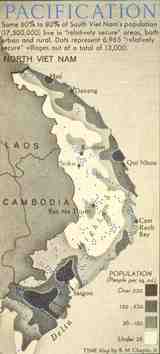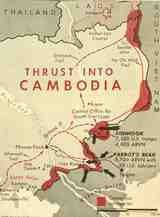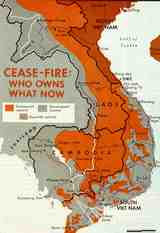Nixon & Vietnamization
1969
 map from Time 3/28/69
map from Time 3/28/69
|
- Richard Nixon replaced Lyndon Johnson
- William Rogers replaced Rusk as Secretary of State
- Melvin Laird replaced Clark Clifford as Secretary of Defense
- Henry Kissinger replaced Walt Rostow as National Security Advisor
- Gen. Creighton Abrams had replaced Westmoreland in 1968
- Adm. John McCain replaced U.S. Grant Sharp as CINCPAC in July 1968
- "two-track" approach - separation of military and political conflicts
- Hanoi and Washington would negotiate military solution
- Saigon and NLF would negotiate political solutions
- "Vietnamization" policy - transfer burden of war from U.S. to ARVN
- "carrot and stick" strategy - negotiate through strength
- Nixon proposed "mutual withdrawal" of troops, no bombing of NV Jan. 25, 1969
- Op. Menu - secret bombing of Cambodia began Mar. 18, 1969 - would continue to 1973 - 16,527 sorties dropped 383,851 tons explosives on Cambodia
- but story leaked by NY Times May 9 - Kissinger ordered wiretaps on 7 NSC staff and 4 reporters
- Abrams withdrew from Ap Bia "Hamburger Hill" in A Shau Valley May 27 after loss of 241 dead
- first 25,000 troops withdrawn June 8 - a "meaningful signal"
- Nixon's Pacific trip in July - met with Thieu, Marcos - "Nixon Doctrine" promised U.S. would honor treaties and extend nuclear shield to allies, but no U.S. troops - "Vietnamization" of ARVN with modern weapons
- CBS Evening News July 28, 1969
- Paris peace talks stalled, despite secret meetings of Kissinger and Xuan Thuy at apartment of Jean Sainteng
- Jimi Hendrix played "Star Spangled Banner" for the 300,000 at Woodstock Music and Art Fair August 15-17 held on Max Yasgur's farm at White Lake near Bethel NY (not at the original site planned near Woodstock NY)
- death of Ho Chi Minh Sept. 2 - replaced by Politburo of Pham Van Dong, Le Duan, Vo Nguyen Giap
- Kissinger and Poland ambassador Walter Stoessel proposed Warsaw talks with Chinese - began Jan. 20, 1970
- national demonstration Oct. 15 by Vietnam Moratorium Committee - 250,000 marched in D.C.
- Nixon's TV speech Nov. 3 appealed to the "silent majority" for support
- Moratorium demonstration of 500,000 in D.C. on Nov. 15 - largest anti-war protest yet - Nixon feared chaos and disorder
- Seymour Hersh published Nov. 12 story about the My Lai massacre of 500 civilians that had occurred Mar. 16, 1968, led by Lt. Wm Calley.
1970
 map from Time 5/11/70
map from Time 5/11/70
|
- Le Duc Tho replaced Xuan Thuy in Paris for 2nd round of talks Feb-Apr. - demanded end of SV government
- NV invasion of Laos and Cambodia Feb. 21 - defeated Hmong army and captured Plain of Jarres - created Khmer Rouge
- Cambodia coup Mar. 18 - neutralist Sihanouk replaced by pro-U.S. Lon Nol
- Nixon saw film Patton Apr. 25 - made decision next day to invade Cambodia
- Cambodia invasion Apr. 30 - 32,000 U.S. troops attack the Fishhook and Parrot's Beak for 2 months - destroy NV supplies and set back NV plans for 2 years - a military success but political disaster
- Kent State demonstration May 4 against ROTC - 4 students killed - article
- Nixon visited Lincoln Memorial demonstration May 9
- Cooper-Church amendment to limit U.S. troops in Laos and Cambodia passed Senate 58-37 on June 30
- Le Duc Tho and Kissinger met in Paris for 3rd round of talks in June
- Hatfield-McGovern amendment to require complete withdrawal from VN failed in Sept.
- Kissinger trip to Pakistan in Oct. - Pres. Khan acted as intermediary with new Chinese leader Chou En-lai - U.S. gave aid to Khan in Mar. 1971 suppression of Bangladesh revolt, but India would defeat Khan and create Bangladesh by Dec. 1971
1971
- Winter Soldier investigation Jan. 31-Feb. 2 by John Kerry and the Vietnam Veterans against the War - 116 vets testified about atrocities committed by U.S. in VN
- Op. Lam Son 719 - ARVN invade Laos Feb. 8 with U.S. air support - but failed to close the Ho Chi Minh trail and showed that Vietnamization had failed
- Kissinger met with Le Duc Tho is secret talks in house on the Rue Darthe in Feb. rather than the formal talks at the Hotel Majestic, but stalled
- ping-pong team visit to China Apr. 10 - Nixon ended of 21-year trade embargo in June
- Nixon's 5-powers speech in Kansas City - world to be dominated by economic superpowers U.S., Russia, W. Europe, Japan, China
- New York Times published Pentagon Papers June 13 - film
- Kissinger visit to Peking July 9 - shook hands with Choe En-lai (unlike Dulles 1954 at Geneva)
- U.S. supported admission of PRC (People's Republic of China) to UN, and began to remove U.S. troops from Formosa
- Marvin Gaye asked "What's Going On?"
1972
 map from Time 5/1/72
map from Time 5/1/72
|
- Nixon arrived in China Feb. 21 - Shanghai Communique
- NV invasion of Quang Tri Mar. 30 - largest since Tet
- Nixon responded with Op. Linebacker Apr. 6 - bombing north of DMZ - B-52 raids on Hanoi and Haiphong Apr. 15
- NV captured Quang Tri City May 1 - low point for Nixon's "Vietnamization" policy - collapse of SV seemed inevitable
- Le Duc Tho and Kissinger met in Paris May 2 - 4th round of talks fail - talks suspended May 4
- Nixon decided May 8 to mine Haiphong harbor and blockade NV coast - 4 aircraft carriers added to 7th Fleet - massive bombing and "jugular diplomacy" successful - NV retreated June 18 and Quang Tri City re-taken
- Nixon arrived in Moscow May 22 - SALT I treaty signed May 29 - Brezhnev agreed to help pressure NV
- Gen. Giap ill with Hodgkin's disease - new military chief Van Tien Dung urged NV to return to Paris talks and make a settlement that would give NV time to recover losses
- Le Duc Tho and Kissinger met in Paris July-Aug. - 5th round of talks finally made progress - NV agreed to coalition government and Kissinger agreed to allow NV troops to remain in place - 9-Point proposal worked out Oct 8-12 - but rejected by Thieu
- Kissinger TV press conference Oct. 26 - "peace is at hand"
- Nixon won election 60.7% to McGovern's 37.5% on Nov. 7
- Le Duc Tho suspended negotiations because of Thieu's opposition
- Nixon ultimatum to NV Dec. 14 to resume negotiations or "suffer the consequences"
 map from Time 11/6/72
map from Time 11/6/72
|
- Op. Linebacker II - the "Christmas bombing" Dec. 17-30 - most intense bombing campaign of the war
1973
- Nixon threatened Thieu Jan. 5 with "gravest consequences"
- Kissinger and Le Duc Tho signed treaty Jan. 27 in Paris - POWs released in 60 days, ceasefire under International Commission of Control and Supervision (ICC), coalition government in SV to arrange elections, U.S. aid to SV to continue
- return began of 591 U.S. POWs
- U.S. troops withdrawn by March, yet bombing continued
- Congress cut off funds for war June 30, to become effective Aug. 15
- War Powers Act passed Nov. 7 over Nixon's veto
1974
1975
- NV attack on Phuoc Long Jan. 5 - start of 3rd Indochina War
- Khmer Rouge attack Phnom Penh - Ambassador John Gunther Dean and 276 U.S. and Cambodian personnel evacuated Apr. 11
- Fall of Saigon Apr. 29 - Ambassador Graham Martin and 7100 U.S. and SV personnel evacuated Apr. 30
Sources: